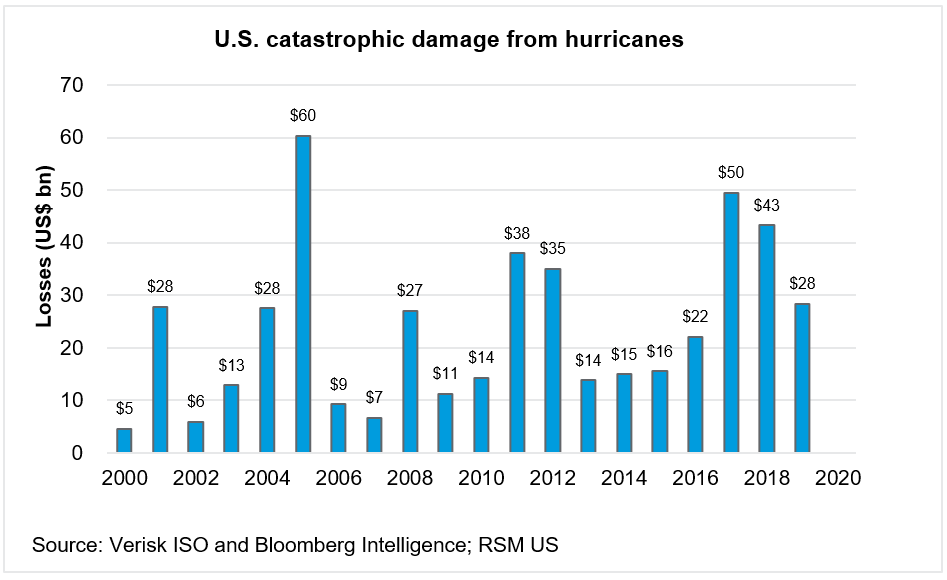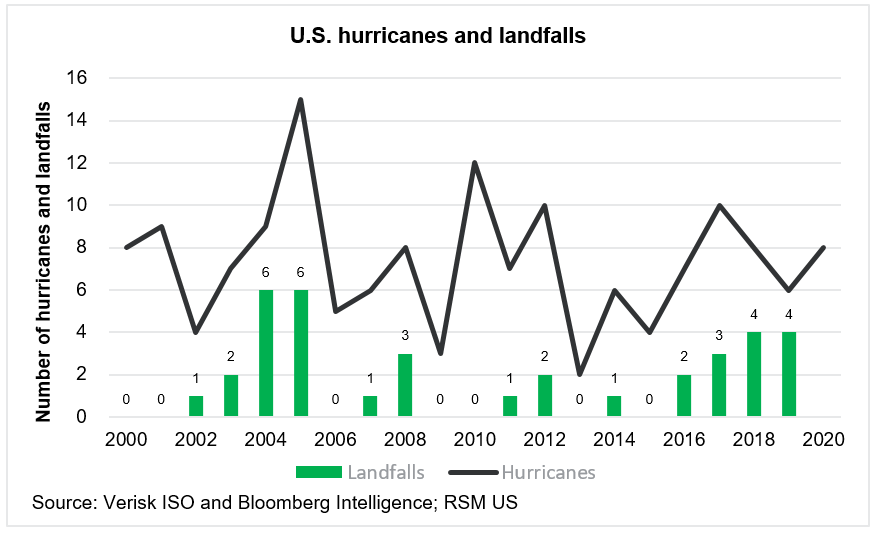Source: RSM US LLP.
REAL ECONOMY BLOG
The Atlantic hurricane season is already off to a busy start, with six named storms having formed as of early July. And it is likely to get worse. The National Oceanic and Atmospheric Administration predicts a 70% chance that this hurricane season will be worse than normal, with just a 10% chance of being less damaging than normal.
For businesses already stretched thin by the coronavirus pandemic, the grim forecast comes at a perilous time.
Anywhere from 13 to 19 named storms are expected to hit in a season that officially lasts through Nov. 30, according to the NOAA. As many as six are projected to become major hurricanes, which are Category 3 or higher, the agency said. An average hurricane season has 12 named storms and three in the major category.
For businesses already stretched thin by the coronavirus pandemic, the grim forecast comes at a perilous time. Sectors such as insurance, real estate, hospitality and healthcare are particularly vulnerable.
To help understand the risks, we take a look at how different industries can prepare for such a catastrophe – before it hits. Each industry faces its own challenges that require specific preparations.

The cost of not preparing could be high. Communities have already been weakened by the pandemic, which has strained the resources needed to mitigate the fallout from a storm, including hotels, temporary housing and general contractors.
The damage of recent hurricane seasons is unsettling. In 2017, Hurricane Harvey had a devastating effect on Houston, throwing thousands out of their homes and severely straining emergency resources. And Hurricane Irma, also in 2017, created social concentrations of people seeking shelter that would pose a risk in an era of pandemic-induced social isolation.

Imagine if a Category 4 or 5 hurricane hit today in those areas. People would know they have to evacuate their homes. Many would try to flee north, but a large number of those would very likely not be able to. Their options would be more limited than before.
Even taking care of the healthy residents caught in the storm would be more difficult. Volunteers who hand out donations or help clean up roads and homes will have a harder time getting to the site, limited by travel restrictions. And when they are there, the pandemic will curtail their ability to interact with people.
The question, then, is how communities and businesses can better prepare for such a worst-case scenario.
Insurance
A major hurricane would pose a significant risk to the insurance industry. As with other storms, property damage would be extensive – hardly a surprise. But it would come on top of the pandemic, which has already led to losses this year because of business interruption and other claims. In addition, insurers have been coping with property damage claims stemming from recent social unrest, which have been significant in some areas.
Many insurers are already in the throes of litigation over vague policy language related to the pandemic.
Many insurers are in the throes of litigation filed by corporations or organizations suing over vague policy language related to the pandemic coverage under business interruption policies. Regardless of how the lawsuits are resolved, the litigation is causing a drag on insurers’ resources.
On the investment side, insurers are facing reduced income because of historically low interest rates.
In the end, this year’s hurricane season will pose a major challenge for insurers, as they seek to cope with lower premium volumes, higher claims and reduced investment income.
So how can they prepare?
- Rethink the catastrophe playbook. The playbook – standard in the insurance industry — is a list of operational effects and challenges of large disasters, and include several steps to follow in order to address these events. It covers the details of coping with disasters: which staff will switch from servicing business-as-usual claims to handling catastrophe claims, deployment of mobile response units to event sites, and the like.
- Reassess assumptions. For example, if a house is destroyed by a hurricane, the insurance company may cover the cost of a hotel, or a temporary apartment. But how does temporary housing work in a pandemic, and are hotels even open? Are they able to accommodate the same capacity as they used to? What if all the apartment complexes that would have provided emergency housing are run by landlords who are bankrupt?
- Review claims servicing. Will staff be available to process claims quickly enough to provide relief to their customers? New technology may be required to adjudicate claims remotely, perhaps with drones or satellite imagery. Companies may have to rethink how they address a surge in claims related to a hurricane if the areas affected are also pandemic hot spots.
- Watch for reinsurer downgrades. In general, reinsurers entered the year with adequate capital supported by well-developed enterprise risk management and hardening reinsurance pricing. But the economic turmoil caused by the pandemic has resulted in thinner capital buffers relative to the past few years, according to Standard & Poor’s.
And that could leave those with outsize hurricane exposures further exposed if 2020 is an above-average catastrophe year. If a large event resulted in reinsurer downgrades, it would have a potential ripple effect on insurers that rely heavily on catastrophe reinsurance coverage for capital relief and further harden the reinsurance markets in future renewals.
Real Estate and Hospitality
The real estate industry has historically been an essential part of any community’s emergency response plan when a hurricane or natural disaster strikes.
Hotels, apartment buildings – even sports arenas – are pressed into service. But this year, operators of multifamily buildings are exposed to the combined threat of the pandemic and an active hurricane season. They need to take additional precautions to ensure that their current disaster planning efforts are adequate. Some of these measures might include:
- Updating emergency contingency plans.
- Assessing business liquidity; if business income is interrupted, how long can the lights stay on?
- Reviewing insurance coverage.
The risks are considerable. Nearly 7.4 million single-family and multifamily homes, with more than $1.8 trillion in combined reconstruction cost value, are at risk in the event of storm surges brought on by a severe hurricane season, according to Corelogic. Florida, Louisiana, New York and Texas bear the greatest risk in terms of exposure of homes that are vulnerable to storm surge.
In a one-two punch, Miami, New York and New Orleans also have above-trend mortgage delinquencies.
And, in a one-two punch, Miami, New York and New Orleans also have above-trend mortgage delinquencies brought on by damage facilitated by the coronavirus.
The outcome of a major storm may very well have outsize repercussions for homeowners, lenders and insurers in these communities.
- Look to underused spaces. Empty hotels and college campuses could offer refuge and meet the guidance of maintaining shelters of fewer than 50 residents.
- Embrace technology. States like Florida are thinking outside of the box by working on an app that will allow counties to pre-register residents for a hotel stay as an evacuation option. In a report presented by the state, this option would require evacuations to start earlier to allow for social distancing at check-in and not overwhelm hotel staff.
This option also places an increased strain on already squeezed state and local government budgets as contracts are negotiated with hotels to pay for up to seven days of lodging and meals expense.
Healthcare
The rising COVID-19 case counts and hospitalizations in the South will add further complications to the already difficult business of treating acute and critically ill patients during a hurricane.
Consider the strains that have already been placed on healthcare in Florida. The intensive care units of more than 50 hospitals in Florida, and eight in Miami-Dade County, had reached their capacity and had no beds available as of July 20, according to Florida’s Agency for Health Care Administration. And this doesn’t even consider the challenge that hospitals are facing in staffing these units.
It all makes for a series of difficult choices if a major storm hits. Healthcare providers in general, and hospitals in particular, must revisit severe weather continuity plans.
Among the considerations:
- Maintain capacity. Most hospitals in affected regions have robust plans to maintain or transfer operations during a storm. But few, if any, have plans that reflect the new reality of COVID-19. For example, many hospitals work to transfer patients inland or to other facilities with independent generators. Can or should hospitals transfer COVID-19 patients? Alternatively, if the destination hospital has a large census of COVID-19 patients, perhaps that destination should be re-evaluated. Bed capacity will become even more strained should a major storm make landfall.
- Keep the lights on. Electricity itself will most likely play an even more important role this season than in the past. Hospitals should evaluate their backup generator capacity within the context of their COVID-19 census; will generators and fuel reserves last long enough for patients on ventilators? Are clinicians prepared to document on paper charts, if necessary? How might virtual health offerings be affected by a prolonged interruption to the power grid?
- Provide shelter safely. Hospitals that act as storm shelters have a unique burden. How can they protect those people who may not have other shelter while maintaining social distance and minimizing spread?
- Stockpile equipment. As hospitals struggle to maintain inventories of personal protective equipment for their clinicians, they may need to consider stockpiling supplies like PPE, bleach wipes and hand sanitizer for people seeking refuge as well.
The Takeaway
While different industries have different needs, they share the common goal of preparing for the worst-case scenario, before it happens. Anything less puts their businesses, as well as their employees and customers, at risk.
This article was written by DAVID MAMANE, LAURA DIETZEL, MATT WOLF, RICK KES AND JESSIKA GARIS and originally appeared on 2022-07-22.
2022 RSM US LLP. All rights reserved.
https://realeconomy.rsmus.com/businesses-already-strained-by-covid-19-should-prepare-for-hurricane-season/
RSM US Alliance provides its members with access to resources of RSM US LLP. RSM US Alliance member firms are separate and independent businesses and legal entities that are responsible for their own acts and omissions, and each are separate and independent from RSM US LLP. RSM US LLP is the U.S. member firm of RSM International, a global network of independent audit, tax, and consulting firms. Members of RSM US Alliance have access to RSM International resources through RSM US LLP but are not member firms of RSM International. Visit rsmus.com/aboutus for more information regarding RSM US LLP and RSM International. The RSM(tm) brandmark is used under license by RSM US LLP. RSM US Alliance products and services are proprietary to RSM US LLP.




